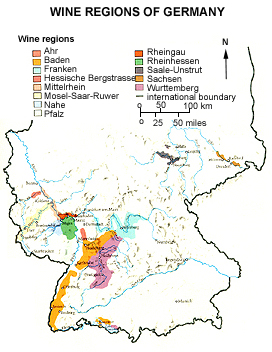| |


Much of Germany's success in wine exports in recent decades has been due to Liebfraumilch and certain other mass-produced medium-sweet white wines. Liebfraumilch is named after a small vineyard near Worms that was once owned by the Church. During the 19th century, the name Liebfraumilch came to be used for wine produced in a much wider area. It was however a term used for a high-quality wine.
Under current law, the wine can come from anywhere in the Rheinhessen, Pfalz, Nahe or Rheingau. The principal grapes used in its production are Riesling, Muller-Thurgau, Silvaner and Kerner. It must be a QbA wine with a certain minimum of residual sugar. Due to competition in the marketplace, Liebfraumilch is often produced down to a price rather than up to a standard. Despite this fact, it remains an immensely popular, in fact the best-selling, wine in the UK.
The same marketing approach has been applied to wines such as Bereich Bernkastel, Piesporter Michelsberg (a Grosslage or wine district) and Niersteiner Gutes Domtal (also a Grosslage). Each of these can come from a wide area, allowing scope for the producers to blend. The only guarantee of quality is the producer's name, as the geographical origin is very unspecific. Growers with quality vineyards in, say, Piesport or Nierstein grumble that these ordinary wines devalue the names of their high-quality ones.
|
|
|
|




